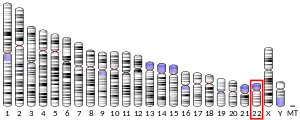DNA dC->dU-editing enzyme APOBEC-3F is a protein that in humans is encoded by the APOBEC3F gene.[3][4][5]
This gene is a member of the cytidine deaminase gene family. It is one of seven related genes or pseudogenes found in a cluster, thought to result from gene duplication, on chromosome 22. Members of the cluster encode proteins that are structurally and functionally related to the C to U RNA-editing cytidine deaminase APOBEC1. It is thought that the proteins may be RNA editing enzymes and have roles in growth or cell cycle control. Alternatively spliced transcript variants encoding different isoforms have been identified.[5]
References
- 1 2 3 GRCh38: Ensembl release 89: ENSG00000128394 - Ensembl, May 2017
- ↑ "Human PubMed Reference:". National Center for Biotechnology Information, U.S. National Library of Medicine.
- ↑ Jarmuz A, Chester A, Bayliss J, Gisbourne J, Dunham I, Scott J, Navaratnam N (Feb 2002). "An anthropoid-specific locus of orphan C to U RNA-editing enzymes on chromosome 22". Genomics. 79 (3): 285–96. doi:10.1006/geno.2002.6718. PMID 11863358.
- ↑ Holmes RK, Koning FA, Bishop KN, Malim MH (Jan 2007). "APOBEC3F can inhibit the accumulation of HIV-1 reverse transcription products in the absence of hypermutation. Comparisons with APOBEC3G". J Biol Chem. 282 (4): 2587–95. doi:10.1074/jbc.M607298200. PMID 17121840.
- 1 2 "Entrez Gene: APOBEC3F apolipoprotein B mRNA editing enzyme, catalytic polypeptide-like 3F".
Human APOBEC3F is another host factor that blocks human immunodeficiency virus type 1 replication. Zheng YH, Irwin D, Kurosu T, Tokunaga K, Sata T, Peterlin BM. J Virol. 2004 Jun;78(11):6073-6. doi: 10.1128/JVI.78.11.6073-6076.2004.
External links
- Human APOBEC3F genome location and APOBEC3F gene details page in the UCSC Genome Browser.
Further reading
- Wedekind JE, Dance GS, Sowden MP, Smith HC (2003). "Messenger RNA editing in mammals: new members of the APOBEC family seeking roles in the family business". Trends Genet. 19 (4): 207–16. doi:10.1016/S0168-9525(03)00054-4. PMID 12683974.
- Franca R, Spadari S, Maga G (2006). "APOBEC deaminases as cellular antiviral factors: a novel natural host defense mechanism". Med. Sci. Monit. 12 (5): RA92–8. PMID 16641889.
- Prashar Y, Weissman SM (1996). "Analysis of differential gene expression by display of 3' end restriction fragments of cDNAs". Proc. Natl. Acad. Sci. U.S.A. 93 (2): 659–63. Bibcode:1996PNAS...93..659P. doi:10.1073/pnas.93.2.659. PMC 40108. PMID 8570611.
- Bonaldo MF, Lennon G, Soares MB (1997). "Normalization and subtraction: two approaches to facilitate gene discovery". Genome Res. 6 (9): 791–806. doi:10.1101/gr.6.9.791. PMID 8889548.
- Dunham I, Shimizu N, Roe BA, et al. (1999). "The DNA sequence of human chromosome 22". Nature. 402 (6761): 489–95. Bibcode:1999Natur.402..489D. doi:10.1038/990031. PMID 10591208.
- Strausberg RL, Feingold EA, Grouse LH, et al. (2003). "Generation and initial analysis of more than 15,000 full-length human and mouse cDNA sequences". Proc. Natl. Acad. Sci. U.S.A. 99 (26): 16899–903. Bibcode:2002PNAS...9916899M. doi:10.1073/pnas.242603899. PMC 139241. PMID 12477932.
- Zheng YH, Irwin D, Kurosu T, et al. (2004). "Human APOBEC3F is another host factor that blocks human immunodeficiency virus type 1 replication". J. Virol. 78 (11): 6073–6. doi:10.1128/JVI.78.11.6073-6076.2004. PMC 415831. PMID 15141007.
- Wiegand HL, Doehle BP, Bogerd HP, Cullen BR (2004). "A second human antiretroviral factor, APOBEC3F, is suppressed by the HIV-1 and HIV-2 Vif proteins". EMBO J. 23 (12): 2451–8. doi:10.1038/sj.emboj.7600246. PMC 423288. PMID 15152192.
- Liddament MT, Brown WL, Schumacher AJ, Harris RS (2004). "APOBEC3F properties and hypermutation preferences indicate activity against HIV-1 in vivo". Curr. Biol. 14 (15): 1385–91. doi:10.1016/j.cub.2004.06.050. PMID 15296757.
- Collins JE, Wright CL, Edwards CA, et al. (2005). "A genome annotation-driven approach to cloning the human ORFeome". Genome Biol. 5 (10): R84. doi:10.1186/gb-2004-5-10-r84. PMC 545604. PMID 15461802.
- Gerhard DS, Wagner L, Feingold EA, et al. (2004). "The status, quality, and expansion of the NIH full-length cDNA project: the Mammalian Gene Collection (MGC)". Genome Res. 14 (10B): 2121–7. doi:10.1101/gr.2596504. PMC 528928. PMID 15489334.
- Haché G, Liddament MT, Harris RS (2005). "The retroviral hypermutation specificity of APOBEC3F and APOBEC3G is governed by the C-terminal DNA cytosine deaminase domain". J. Biol. Chem. 280 (12): 10920–4. doi:10.1074/jbc.M500382200. PMID 15647250.
- Kimura K, Wakamatsu A, Suzuki Y, et al. (2006). "Diversification of transcriptional modulation: large-scale identification and characterization of putative alternative promoters of human genes". Genome Res. 16 (1): 55–65. doi:10.1101/gr.4039406. PMC 1356129. PMID 16344560.
- Zennou V, Bieniasz PD (2006). "Comparative analysis of the antiretroviral activity of APOBEC3G and APOBEC3F from primates". Virology. 349 (1): 31–40. doi:10.1016/j.virol.2005.12.035. PMID 16460778.
- Tian C, Yu X, Zhang W, et al. (2006). "Differential requirement for conserved tryptophans in human immunodeficiency virus type 1 Vif for the selective suppression of APOBEC3G and APOBEC3F". J. Virol. 80 (6): 3112–5. doi:10.1128/JVI.80.6.3112-3115.2006. PMC 1395459. PMID 16501124.
- Stenglein MD, Harris RS (2006). "APOBEC3B and APOBEC3F inhibit L1 retrotransposition by a DNA deamination-independent mechanism". J. Biol. Chem. 281 (25): 16837–41. doi:10.1074/jbc.M602367200. PMID 16648136.
- Wichroski MJ, Robb GB, Rana TM (2006). "Human retroviral host restriction factors APOBEC3G and APOBEC3F localize to mRNA processing bodies". PLOS Pathog. 2 (5): e41. doi:10.1371/journal.ppat.0020041. PMC 1458959. PMID 16699599.

